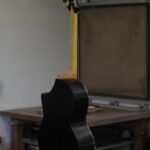High-speed scales and fast-playing often appear in songs for intermediate to advanced guitarists. They are cool when done well, but difficult to play smoothly. How can I play fast scales and fast passages well? I will mainly explain how to play and practice with your right hand.

You can find an article about classical guitar practice here:

- It is difficult to play fast scales and fast passages with the guitar
- How to play and practice when you can’t play fast scales and fast passages smoothly
- Let’s practice the normal scale first
- Let’s practice at a slower tempo
- You don’t have to stick to using just your index and middle fingers
- Using ”Figueta” technique
- Playing a scale with three fingers
- Determine the fingering, taking into account of the fingers when straddling several strings
- Practice with “Planting” technique
- All that’s left is practice
It is difficult to play fast scales and fast passages with the guitar
It is difficult to play fast scales and fast passages with the guitar.
One reason for this: when playing multiple notes on a single string, you have to play the next note while muting the previous one.
In the case of a piano, different notes are assigned to different keys. A guitar, on the other hand, you may need to produce several notes on one string.
For a smooth performance, the next note should be played while extending the previous note as much as possible. However, in the case of high-speed scales and fast-playing, the right and left hands must be synchronized at very short timings. This is very difficult.
Another reason of increasing difficulty is right-hand string-straddling (moving the right hand back and forth across multiple strings).
If you just keep playing the same string at the same pace, it’s not so difficult. But whether you’re playing ascending or descending scales, you have to straddle the strings somewhere.
It’s difficult to straddle several strings well. But it’s also difficult to keep playing smoothly without breaking the tempo when straddling the strings.
How to play and practice when you can’t play fast scales and fast passages smoothly
If you feel that you can’t play fast scales and fast passages well, here are some recommendations to play and practice them.
Let’s practice the normal scale first
If you can’t play normal scales, you can’t play fast scales smoothly.
Check out this article to practice scales:
As mentioned in the article above, practicing scales is not only useful for scales, but for all guitar playing.
Let’s practice at a slower tempo
Just because you can’t play fast scales and fast passages well, I don’t recommend to rush and practice a pace that you can’t play well.
You should practice again and again at a pace you can play. And you can gradually increase the tempo.
Playing too fast can damage your fingers.
You don’t have to stick to using just your index and middle fingers
Many people use their index finger (i) and middle finger (m) alternately when playing the guitar at a faster pace.
However,movements of adjacent fingers tend to interfere with each other. Therefore, the index and middle fingers are not always the best fingers for high-speed scales and fast-playing..
In my case, my index finger (i) and ring finger (a) move more smoothly than moving my index finger (i) and middle finger (m) alternately.
If you can’t move your right hand well, please try it once.
By the way, my middle finger (m) and ring finger (a) move more smoothy than my index finger (i) and middle finger (m) alternately.
Using ”Figueta” technique
The “Figueta” is recommended for high-speed scales and fast-playing with bass strings.
Figueta is a technique in which the thumb (p) and index finger (i) are used alternately. Since the thumb is highly independent of the other fingers, you can play smoothly.
It can be difficult to play the bass strings with your index, middle and ring fingers. But it will be easier to play with your thumb.
Playing a scale with three fingers
If you have to play a very fast scale or passage, you won’t be able to keep up with just 2 fingers.
A useful tool in such cases is the 3-finger scale.
Specifically, the scale is played in the order of ring finger → middle finger → index finger, like a tremolo.
This method will allow you to move your fingers 2/3 as fast and give room in your mind.
The 3-finger scale is also very effective for straddling multiple strings. I will discuss this later.
The ability to play the 3-finger scale depends on whether or not you can use your ring finger well (also means, whether or not you can play the tremolo well).
If you have trouble with the 3-finger scale, I suggest you try practicing the tremolo.
Determine the fingering, taking into account of the fingers when straddling several strings
Fingering is important for overcoming string-straddling.
When straddling multiple strings, it is easier to use the ring finger for the ascending scale and the index finger for the descending scale. So it’s better to determine the fingering so that you can use your fingers in this way.
Even if you play the scale with your index and middle fingers, it’s a good idea to use your ring finger as well so that your fingers are in the suitable position when you straddle strings.
Instead of doing that, it may be more efficient to start with a 3-finger scale and occasionally skip a finger to adjust the straddling fingers.
Practice with “Planting” technique
The key to fast scales is to be ready for fingerpicking the next note while you’re playing one note.
Unlike slower tempo scales, you have to prepare in advance to be ready in time.
Planting is an effective way to make this habit.
“Planting” is the technique of placing your fingers on the strings before fingerpicking them.
However, I am not suggesting that you do “Planting” for a fast scale. We use Planting for practice.
Specifically, this is how it works: dare to play a fast scale very slowly. In doing so, as soon as you play one note, try to place your finger on the string where you want to play the next note.
If you do this, you play each note (except for the string-straddling) sharply separated like a staccato.
The trick is to do “Planting” so that this staccato sound can be as short as possible.
“You can make each note as short as possible” means “you’re ready enough to play the next string”. If you practice repeatedly, you will feel its effect relatively quickly.
All that’s left is practice
Just because you’ve done the work introduced in this article, it doesn’t mean that you’ll be able to play fast scales and fast passages immediately.
However, you will play them well more efficiently than if you just practice recklessly.
Not everyone is good at high-speed scales and fast-playing. So you can make a strong impression if you’ve done them well.
Don’t be in a hurry, try them little by little.






